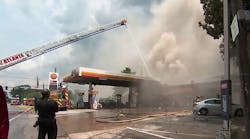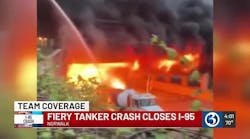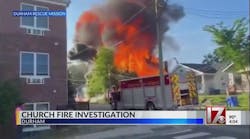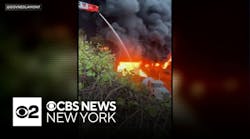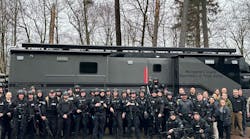According to the National Volunteer Fire Council, 65% of all firefighters in the United States in 2016 were volunteers.
But the number of people joining volunteer fire departments is on the decline, and not just in Daviess County.
"The volunteer service on the fire side is really suffering," said Randy Lawson, executive director for the Kentucky Firefighter's Association. To younger people, being a volunteer firefighter "is not as appealing as it used to be," he said.
"The volunteer fire departments, not just in Kentucky but nationwide, are crying for help."
Several chiefs of area volunteer departments said they have had fewer people signing on to be firefighters for some time. Having fewer volunteers on a department's personnel roster has an impact on the response because there are simply fewer people to come to a fire or emergency run. And, as the current generation of veterans gets older, there aren't as many younger volunteers coming up to learn from their experience and eventually take their places.
Officials with the Daviess County Fire Department are launching a special team at the beginning of the year to help volunteer departments cope with having fewer available firefighters.
The team is "a short-term fix for a long-term issue," said Shaun Blandford, assistant chief with the Daviess County Fire Department.
The issue of declining numbers of volunteer firefighters isn't new. The U.S. Fire Administration, which is a branch of FEMA, published a study on why there were fewer volunteer fire departments in 2007. That study cited information from the Bureau of Labor Statistics and St. Joseph University, which found the most common reason volunteers cite when they leave the fire service is they lack the time to volunteer.
Pat Thompson, chief of the Airport-Sorgho Fire Department, said potential volunteers are often too busy to volunteer.
"When we were growing up, we probably didn't have as many activities available to us," Thompson said. "Now, people are working two jobs."
Bob Newman, chief of the Thruston-Philpot Fire Department, also said it's "harder and harder to get volunteers."
"Everybody is so busy nowadays," he said.
In addition to people being busy with families, careers and activities, there's a large time commitment to be a volunteer, Newton said.
"There are 150 hours of certification training they have to have, and then they get certified by the state," Newman said. "It takes a while to where you can utilize them completely."
Some departments are busier than others. The Thurston-Philpot Fire Department made 1,200 runs in 2018. In the average year, the department's volunteers make about 750 medical runs, Newman said.
Greg Schadler, chief of the St. Joseph Fire Department, said "there are not a lot of young people coming up. We've had four or five in the last year, and that's a good number."
The challenge, he said, is "just trying to retain them."
It can take a volunteer "over two years" to get through the required training, he said.
"The younger generation, they aren't what they used to be," Schadler said. "Everyone used to like to go on fire runs and help their neighbors."
David Stevens, chief of the Beaver Dam Fire Department, said his department has 34 volunteers. That doesn't mean 34 will show up for a fire or emergency run because everyone is not available all of the time.
"When you have 30 people on your roster ... you might end up with 10 on the scene," Stevens said.
A volunteer department with a small number of volunteers might have only three or four people respond to a fire, he said.
"There are a lot of departments that are hurting," Stevens said.
With fewer young people involved, the volunteer service is getting older, retired Daviess County Fire Chief Dwane Smeathers said.
"The older guys are still around, but the younger guys are too busy," Smeathers said. "They've got families (and children's activities like) football, soccer, dance.
"It's a big responsibility, and the volunteer service is paying for it," Smeathers said.
In areas like St. Joseph, several members of the department are farmers, so they are able to respond to a daytime call, Schadler said.
"St. Joseph probably has the most individuals available during the day," Thompson said.
But departments with volunteers who work jobs away from their homes are having a hard time fielding firefighters during the day.
"The operational effect (of having fewer volunteers) has probably been on daytime response," Thompson said. "... There are not that many people (available) during the day, because there are not as many people around."
Of the aging of the volunteer service, Thompson said, "out of our 30 people, we probably have seven or eight of us who are over 50, and probably another five or six in their 40s."
Stevens said, "a lot of departments, they (have) people with 20-plus years" of experience, "but not so much of the younger generation.
"There are a lot of departments that have their 20- and 30-year veterans, and they are getting older," Stevens said.
To address the issue declining volunteers, Blandford said the county fire department has created an Advanced Large Incident Response Team as a way to increase firefighter numbers at large fires or emergencies where additional crews are needed.
The ALIRT members will begin responding to calls on Jan. 1.
"We have highly trained, highly qualified young people" in the departments, Blandford said, "but they are spread across the county."
The team consists of 32 members, who are from volunteer departments across the county and are members of the city and county paid crews who have volunteered to respond to calls on their days off. While volunteer departments and the county's paid fire crews respond together to all fire calls and emergency runs, the idea behind ALIRT is that the team will be called in as a second crew of firefighters to relieve crews that naturally wear out when fighting a large fire, or need a break while firefighting in the heat or cold.
Because the team members come from every department, activating the team won't strip any one department of its fire coverage, Blandford said.
"We are just pulling one or two firefighters from every department, leaving the rest of the department intact," Blandford said.
"I'm afraid it won't solve the issue in the long term" of declining volunteer numbers, he said. "It's a short-term fix for a long-term issue."
———
©2019 the Messenger-Inquirer (Owensboro, Ky.)
Visit the Messenger-Inquirer (Owensboro, Ky.) at www.messenger-inquirer.com
Distributed by Tribune Content Agency, LLC.

